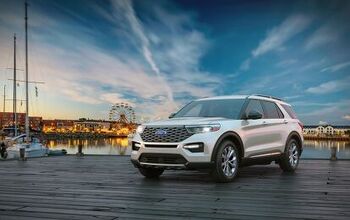BMW, Daimler, Ford, and VW Are Planning a High-Power EV Charging Network to Connect Europe

Due to a wildly cooperative joint venture between German carmakers and the Ford Motor Company, owning an electric vehicle in Europe will soon become far more practical.
Daimler AG, BMW, Ford, and Volkswagen Group intend to establish a continent-wide network of ultra-fast 350 kW capacity charging sites that will begin juicing up vehicles as early as next year.
The strategy has already identified 400 future charging locations, mainly along European highways, with an end goal of several thousand charge points by 2020 — the same year that Volkswagen plans to unveil its long-range EV and hopes to have already sold over one million electric cars.
By helping enable more long-distance travel for European EV drivers, the charging network will also help consumers feel more comfortable when these companies begin skewing their production lines more heavily toward electric vehicles. Current charging times using rapid modern charging points average over thirty minutes, but the future Euro network wants to eventually make recharging as convenient as refueling at conventional gas stations.
That certainly takes away some of the EV sting.
“The availability of high-power stations allows long-distance e-mobility for the first time and will convince more and more customers to opt for an electric vehicle,” Daimler CEO Dieter Zetsche said in a statement.
The charging network will be based upon a Combined Charging System (CCS), a quick-charging method that uses a tandem AC/DC combination coupler delivering a maximum 350 kW delivery charging rate. For comparison, Tesla only recently upgraded its own Supercharger network to 145 kW.
BMW, Daimler, Ford and VW Group will be equal partners in the joint endeavor and are encouraging other automakers, along with regional partners, to participate.
[Image: BMW, Daimler, Ford Motor Co., and VW Group]

A staunch consumer advocate tracking industry trends and regulation. Before joining TTAC, Matt spent a decade working for marketing and research firms based in NYC. Clients included several of the world’s largest automakers, global tire brands, and aftermarket part suppliers. Dissatisfied with the corporate world and resentful of having to wear suits everyday, he pivoted to writing about cars. Since then, that man has become an ardent supporter of the right-to-repair movement, been interviewed on the auto industry by national radio broadcasts, driven more rental cars than anyone ever should, participated in amateur rallying events, and received the requisite minimum training as sanctioned by the SCCA. Handy with a wrench, Matt grew up surrounded by Detroit auto workers and managed to get a pizza delivery job before he was legally eligible. He later found himself driving box trucks through Manhattan, guaranteeing future sympathy for actual truckers. He continues to conduct research pertaining to the automotive sector as an independent contractor and has since moved back to his native Michigan, closer to where the cars are born. A contrarian, Matt claims to prefer understeer — stating that front and all-wheel drive vehicles cater best to his driving style.
More by Matt Posky
Latest Car Reviews
Read moreLatest Product Reviews
Read moreRecent Comments
- Fred This is one car I never see anymore. Where did they all go?
- Daniel Bridger The increased cost of electricity is raging faster than the government's manipulation of ICE fuel.
- Zipper69 Why the choice of a four door shell.Packing this tech into Stinger would have been awesome.
- Eric I have no desire to have an EV. Too expensive, no charging facilities within 50 miles are even planned, unproven technology, arguably even more environmentally harmful than ICE vehicles. Besides being a status symbol and to signal virtue, what's to like?
- Zipper69 Alfa Romeo Europa


































Comments
Join the conversation
"actually purchased a barony from a (very small, not quite legitimate) country." Hah! A Baron of Sealand! I've been very tempted just for the hell-of-it and some pretty cool history behind those old forts.
Currently, there are no passenger electric cars capable of charging at 350 kW - or the even more powerful and faster 400 kW. We won't be seeing any until at least 2018. I'd rather seem them skip the 350 kW and just go straight to 400 kW. Here are some links that explain all of this a bit better: https://electrek.co/2016/10/18/new-ultra-fast-charging-350-kw-stations-evs-europe-audi-bmw/ Here's a 400 kW announcement: http://www.ittcannon.com/news/itt%E2%80%99s-cannon-brand-to-introduce-next-generation-u/